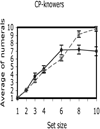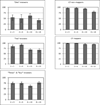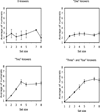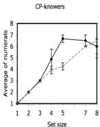One, two, three, four, nothing more: an investigation of the conceptual sources of the verbal counting principles
- PMID: 17208214
- PMCID: PMC3880652
- DOI: 10.1016/j.cognition.2006.10.005
One, two, three, four, nothing more: an investigation of the conceptual sources of the verbal counting principles
Abstract
Since the publication of [Gelman, R., & Gallistel, C. R. (1978). The child's understanding of number. Cambridge, MA: Harvard University Press.] seminal work on the development of verbal counting as a representation of number, the nature of the ontogenetic sources of the verbal counting principles has been intensely debated. The present experiments explore proposals according to which the verbal counting principles are acquired by mapping numerals in the count list onto systems of numerical representation for which there is evidence in infancy, namely, analog magnitudes, parallel individuation, and set-based quantification. By asking 3- and 4-year-olds to estimate the number of elements in sets without counting, we investigate whether the numerals that are assigned cardinal meaning as part of the acquisition process display the signatures of what we call "enriched parallel individuation" (which combines properties of parallel individuation and of set-based quantification) or analog magnitudes. Two experiments demonstrate that while "one" to "four" are mapped onto core representations of small sets prior to the acquisition of the counting principles, numerals beyond "four" are only mapped onto analog magnitudes about six months after the acquisition of the counting principles. Moreover, we show that children's numerical estimates of sets from 1 to 4 elements fail to show the signature of numeral use based on analog magnitudes - namely, scalar variability. We conclude that, while representations of small sets provided by parallel individuation, enriched by the resources of set-based quantification are recruited in the acquisition process to provide the first numerical meanings for "one" to "four", analog magnitudes play no role in this process.
Figures




 ; “two”:
; “two”:  ; “three”:
; “three”:  ; “four”:
; “four”:  ). Figures in the right column show the distributions for “five” (
). Figures in the right column show the distributions for “five” ( ), “six” (
), “six” ( ), “seven” and “eight” (
), “seven” and “eight” ( ); “nine” and “ten” (
); “nine” and “ten” ( ); and all numerals beyond “ten” (
); and all numerals beyond “ten” ( ). The distributions for “seven” and “eight” were added together to simplify the figures as were the distributions for “nine” and “ten” and the distributions for numerals greater than “ten”.
). The distributions for “seven” and “eight” were added together to simplify the figures as were the distributions for “nine” and “ten” and the distributions for numerals greater than “ten”.


Comment in
-
Why the verbal counting principles are constructed out of representations of small sets of individuals: a reply to Gallistel.Cognition. 2008 May;107(2):650-62. doi: 10.1016/j.cognition.2007.09.008. Epub 2007 Dec 3. Cognition. 2008. PMID: 18061156 Free PMC article. No abstract available.
Similar articles
-
Do analog number representations underlie the meanings of young children's verbal numerals?Cognition. 2017 Nov;168:243-255. doi: 10.1016/j.cognition.2017.06.022. Epub 2017 Jul 18. Cognition. 2017. PMID: 28732303
-
Preverbal and verbal counting and computation.Cognition. 1992 Aug;44(1-2):43-74. doi: 10.1016/0010-0277(92)90050-r. Cognition. 1992. PMID: 1511586 Review.
-
Re-visiting the competence/performance debate in the acquisition of the counting principles.Cogn Psychol. 2006 Mar;52(2):130-69. doi: 10.1016/j.cogpsych.2005.07.002. Epub 2005 Dec 20. Cogn Psychol. 2006. PMID: 16364281
-
Why the verbal counting principles are constructed out of representations of small sets of individuals: a reply to Gallistel.Cognition. 2008 May;107(2):650-62. doi: 10.1016/j.cognition.2007.09.008. Epub 2007 Dec 3. Cognition. 2008. PMID: 18061156 Free PMC article. No abstract available.
-
Ontogenetic Origins of Human Integer Representations.Trends Cogn Sci. 2019 Oct;23(10):823-835. doi: 10.1016/j.tics.2019.07.004. Epub 2019 Aug 19. Trends Cogn Sci. 2019. PMID: 31439418 Review.
Cited by
-
Number-concept acquisition and general vocabulary development.Child Dev. 2012 Nov;83(6):2019-27. doi: 10.1111/j.1467-8624.2012.01815.x. Epub 2012 Jul 16. Child Dev. 2012. PMID: 22803603 Free PMC article.
-
Developmental Changes in the Profiles of Dyscalculia: An Explanation Based on a Double Exact-and-Approximate Number Representation Model.Front Hum Neurosci. 2011 Dec 21;5:165. doi: 10.3389/fnhum.2011.00165. eCollection 2011. Front Hum Neurosci. 2011. PMID: 22203797 Free PMC article.
-
Symbol grounding of number words in the subitization range.Psychol Res. 2021 Mar;85(2):720-733. doi: 10.1007/s00426-019-01265-4. Epub 2019 Nov 13. Psychol Res. 2021. PMID: 31722039
-
Young children 'solve for x' using the Approximate Number System.Dev Sci. 2015 Jan;18(1):38-49. doi: 10.1111/desc.12177. Epub 2014 Mar 3. Dev Sci. 2015. PMID: 24589420 Free PMC article.
-
Numerosity and number signs in deaf Nicaraguan adults.Cognition. 2011 Dec;121(3):427-36. doi: 10.1016/j.cognition.2011.07.007. Epub 2011 Sep 6. Cognition. 2011. PMID: 21899832 Free PMC article.
References
-
- Barner D, Thalwitz D, Wood J, Carey S. Children's ability to distinguish 'one' from 'more than one' and the acquisition of singular-plural morpho-syntax. Developmental Science. (in press). - PubMed
-
- Barner D, Wood J, Hauser M, Carey S. Evidence for a non-linguistic distinction between singular and plural sets in wild rhesus monkeys. (under review). - PubMed
-
- Barth HC, Kanwisher N, Spelke E. The construction of large number representation in adults. Cognition. 2003;86:201–221. - PubMed
-
- Brannon EM. The development of ordinal numerical knowledge in infancy. Cognition. 2002;83(3):223–240. - PubMed
-
- Brannon EM, Van de Walle GA. The development of ordinal numerical competence in young children. Cognitive Psychology. 2001;43:53–81. - PubMed
Publication types
MeSH terms
Grants and funding
LinkOut - more resources
Full Text Sources
Miscellaneous

